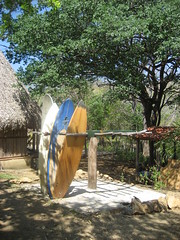This recipe for Italian salsa verde — not to be confused with the spicy Mexican sauce of the same name — comes from the Food section of the Miami Herald. Salsa Verde is bright with herbs and deeply flavored with olive oil, garlic, capers, lemon, and sometimes anchovies. It’s full of flavor and packs a ton of nutrition from pathogen fighting herbs.
There’s no long simmering or blending required. You simply whisk the ingredients together until you reach the consistency of a loose pesto. This sauce is versatile: add it to a salad, use as a dip, top fish or meat after cooking or grilling.
Here are some tips:
• When zesting a lemon, avoid the bitter white pith beneath. The zest brightens the flavor of the sauce. A Microplane zester is an excellent tool for the job.
• Feel free to vary proportions. I tend to use less oil for a thicker consistency when I serve salsa verde alongside roasted meats and grilled vegetables, and more oil with fish or chicken. Here’s the recipe along with a serving suggestion: wild caught salmon!
Crispy Salmon with Salsa Verde
- 1/2 cup chopped fresh flat-leaf parsley
- 3 tablespoons chopped fresh chives
- 1/2 teaspoon chopped fresh thyme
- 1/2 teaspoon chopped fresh oregano
- 1/4 teaspoon chopped fresh rosemary
- 1/4 teaspoon chopped fresh sage
- 3 tablespoons drained capers, chopped
- 2 garlic cloves, minced
- Grated zest from 1 lemon
- 1/2 cup extra-virgin olive oil
- Salt and freshly ground pepper
- 6 salmon fillets (about 2 pounds total), skin removed
- 3 tablespoons lemon juice
- 6 lemon wedges, for garnish
Procedure:
Mix the herbs with the capers, garlic, lemon zest and 6 tablespoons of the olive oil. Season to taste with salt and pepper.
Heat the remaining 2 tablespoons oil over high heat in a large nonstick pan. Cook salmon in a single layer until golden and crisp, about 3 minutes. Turn, season with salt and pepper, and cook other side until golden and crisp, 2 to 3 minutes.
Stir lemon juice into herb mixture. To serve, place a salmon fillet on each plate and top with the sauce. Serve garnished with lemon wedges. Makes 6 servings.
Source: Adapted from “Wine Country Cooking” by Joanne Weir (Time-Life $27.50).
Per serving: 341 calories (68 percent from fat), 25.6 g fat (5 g saturated, 11.2 g monounsaturated), 67 mg cholesterol, 25.4 g protein, 1.4 g carbohydrates, 0.4 g fiber, 203 mg sodium.
Carole Kotkin is manager of the Ocean Reef Club cooking school and co-author of “Mmmmiami: Tempting Tropical Tastes for Home Cooks Everywhere.”


















